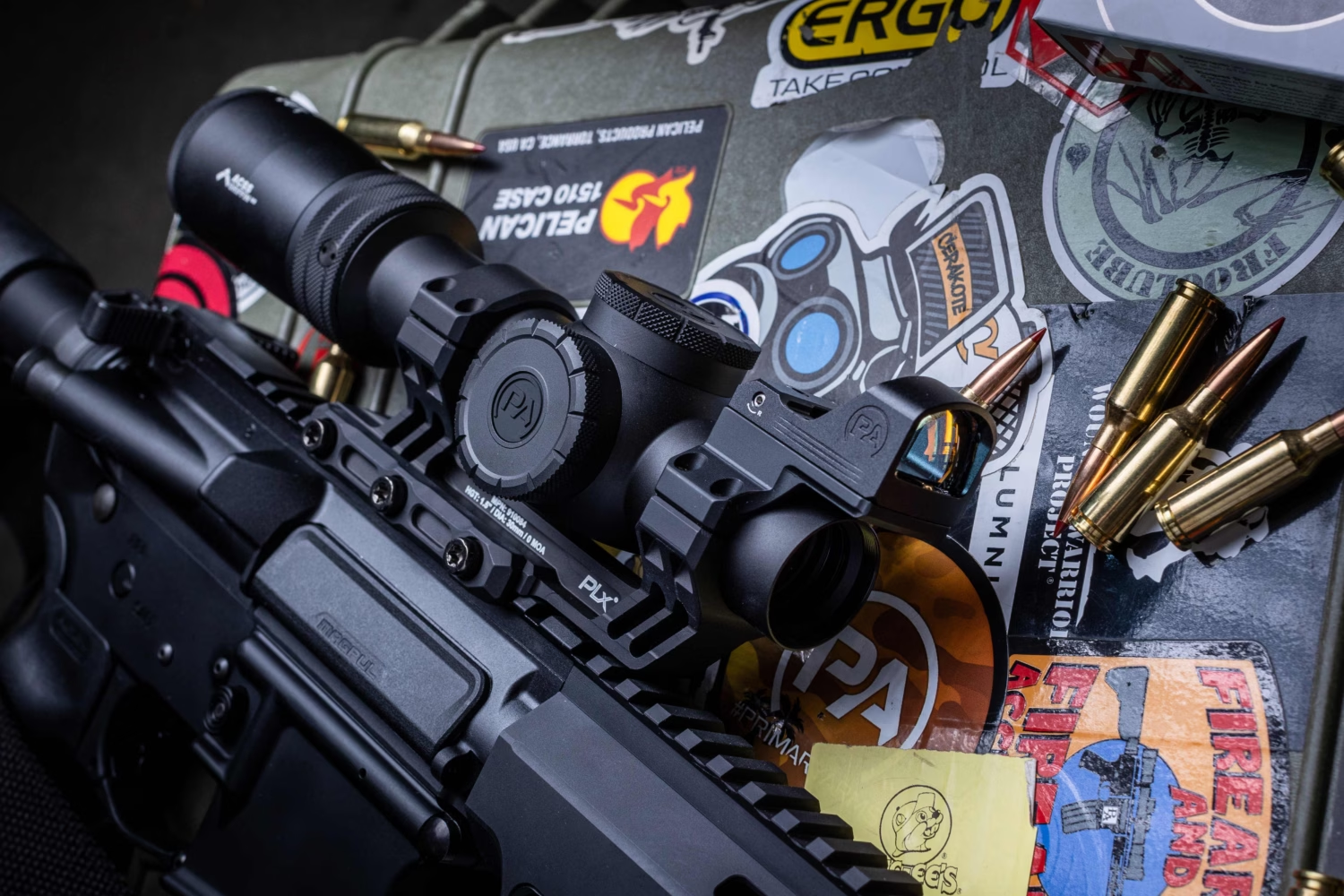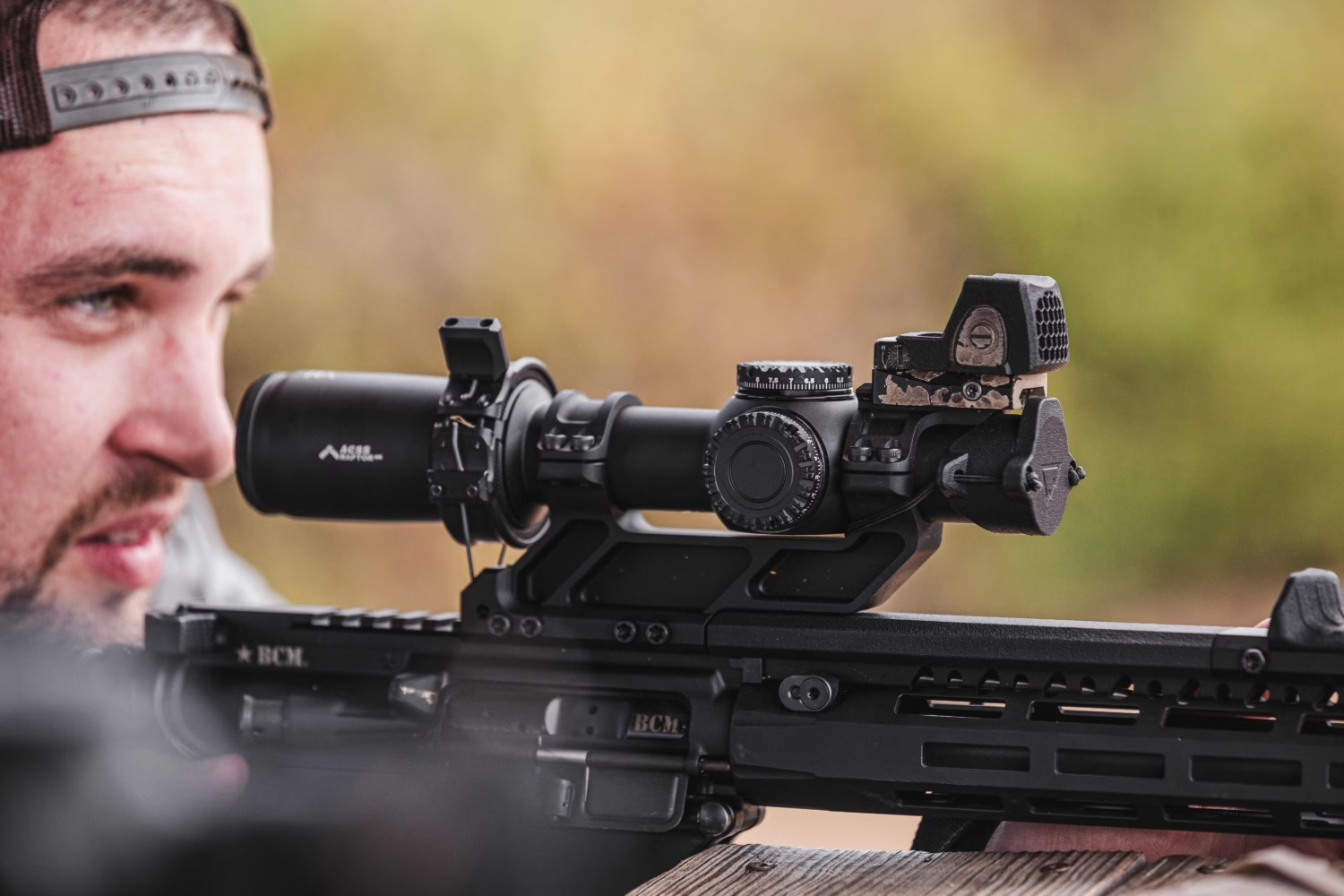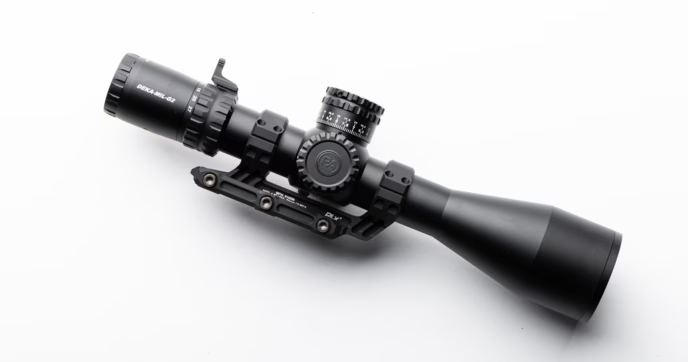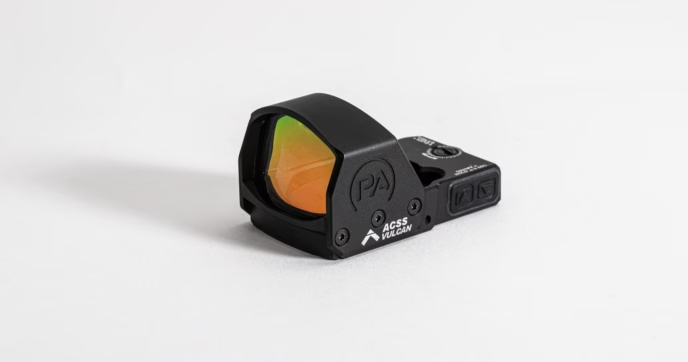Low-power variable optics have rapidly become one of the most popular optics for semi-automatic rifles due to one primary reason: versatility. An AR-15 or similar rifle is already an extremely versatile firearm, capable of performing equally well at 5 yards or 500, and an LPVO allows the user to take full advantage of that breadth of capability.
Even so, they are not without their drawbacks, leading many users to augment their scope with a red dot sight in order to have the best of all possible options. But that still leaves them with a choice—piggyback mounting or offset.

Red Dot Vs LPVO
It’s important to understand the benefits and limitations of each optic in the system before deciding how you will configure them.
Red dots offer the benefits of speed and an incomparable field of view. Their daylight bright aiming points, infinite eye relief, and extremely forgiving eye box make them by far the easiest optics to acquire a sight picture with, particularly when firing on the move or from an improvised or unstable position. They don’t require a cheekweld to use effectively and are wonderfully simple, making them an easy, intuitive option for even the most novice of marksmen.
The nearly unlimited field of view of a red dot is often undervalued; while the body of the red dot may obstruct some small portion of vision, your field of view with a red dot is nearly the same as with your bare eye.
Scopes, on the other hand, trade speed for precision. They offer more sophisticated reticles, which are etched into the glass or otherwise permanently rendered so that they don’t depend on batteries for functionality. The magnification they offer is essential for precise marksmanship at extended ranges and can be instrumental for positive target identification and feedback, such as spotting impacts from missed shots.
LPVOs are already something of a trade-off, offering reduced magnification compared to larger optics but with the benefit of maintaining a 1x or similar minimum power, which allows them to be used effectively at short ranges. However, they still struggle to offer the same speed and ease of use of a red dot, which is why the two are often paired together.
By combining both an LPVO and reflex sight, users are able to take advantage of the benefits of both and use each to account for the shortcomings of the other, albeit at the cost of some additional weight. With a piggyback or offset setup, users can rapidly shift between a red dot for short-range work or target location and a scope for precise marksmanship, all without ever taking their hands off their rifle.

Piggyback Vs Offset Mounts
There are two primary methods of mounting a secondary red dot to your rifle.
The first is piggyback mounting, also known as 12 o’clock mounting. This configuration situates the red dot directly on top of the scope and inline with the rifle. To transition from your scope to your piggybacked red dot, you would only need to shift your head slightly higher, often moving from a cheekweld to more of a chinweld.
An alternative popular mounting option is offset mounting, which positions the red dot alongside the LPVO at an angle. This configuration allows you to transition between sights by rolling your wrists and tilting the rifle, while maintaining more or less the same cheekweld.
Both methods come with certain advantages and drawbacks.
Piggyback Mount: Pros And Cons
Piggyback sights place the red dot inline with your primary optic and bore, but at a considerably taller height than offset mounting. This is both a pro and a con. The increased height necessitates a less secure cheekweld and increases mechanical offset considerably, which can make marksmanship at extremely close ranges—generally anything inside fifteen yards or so—more difficult. Since short-range work is one of the primary motivations for adding a secondary dot, that’s a pretty significant drawback.
On the other hand, the increased height offers many of the same benefits with a piggybacked dot as it does with a primary dot, namely reduced neck strain, a more “heads up” aiming position, and easier use with night vision. The last point really can’t be overstated—a piggyback red dot is going to be much easier to use with head-mounted NODs than an offset dot. If your motivation for adding a secondary dot to your rifle is improved passive aiming capability with your night vision devices, piggyback mounting is almost always going to be the answer.
Piggyback mounting also keeps all your optics in the same plane. Transitioning between them requires only a slight movement of your head and can be done even when supported by a bipod or barricade. This makes a piggyback sight ideal for gross sighting before transitioning to a magnified optic. Some competitors even use piggybacked red dot sights on bolt-action rifles for PRS and similar competitions for this reason.
Offset Mount: Pros And Cons
Offset mounting benefits from a more secure cheekweld and shorter height over bore. It’s a favorite of competitive marksmen, as the setup allows for very precise fire at nearly any range with minimal need to compensate for height over bore.
With an offset red dot, users transition between sights by rolling the rifle 30-50 degrees. This is much quicker than dialing your magnification ring or flipping in and out a magnifier, and often even slightly quicker than transitioning to a piggybacked dot. The nature of the transition makes it easy to develop the muscle memory of precisely how far to roll your rifle to acquire your dot.
Offset dots also offer more flexibility in where exactly the dot is placed on your rifle’s rail. Some users prefer to run their dot in place of their rear iron sight, placing it very close to the eye, while others prefer it in front of their scope or even on the handguard of their rifle. Certain AR scope mounts are designed with attachment points for offset red dots as well. In contrast, the only place to install a piggybacked red dot is on top of your scope and in front of the turret, unless you want to forgo the ability to dial adjustments for range.
Best Applications
Both configurations are valid and have their advantages. Piggyback-mounted red dots offer greater compatibility with night vision, making them the clear choice for that use case. They also work well as a gross aiming measure for precision rifles, or for those who already have many hours of training with an extra-tall red dot mount.
Offset dots are best used by those who want a secure head position and low height over bore for their red dot. They are popular with competitors, as the more stable head position has some small benefits for the type of dynamic marksmanship demanded by 3-Gun and similar competitions.
Ultimately, the difference between the two mounting positions is largely going to come down to training and personal preference. Some users prefer transitioning by moving their head without having to adjust their grip on their rifle, while others appreciate the stability of not having to move their head and only rotate their wrists to transition.

Mounting Options
Regardless of which option you choose, you’re going to need a way to mount your dot. There are several options for each style of mounting.
Piggyback Optic Mounts
Piggyback optic mounts only have a few options when it comes to mounting. You can either select a scope mount that offers optic mounting compatibility or use a ring mount.
Ring mounts are generally considered to be an inferior method of mounting. These mounts are essentially the same as a scope ring, but instead of clamping to a Picatinny or dovetail rail, they offer a mounting surface for a mini or micro red dot. While they are certainly secure enough for most applications, they cannot match the durability of a mount that attaches directly to the scope mount and are at risk of being knocked off zero or twisted if struck hard enough.
Certain scope mounts offer integrated piggyback mounting solutions. The most common version of this is a replacement top scope ring section that has a red dot mount machined into it. This design is much more secure because the red dot mount is a part of the ring section itself, which is then attached to the mount base with bolts. This makes it impossible for it to be twisted by impact—the ring itself would have to be twisted or deformed for that to happen, and the amount of force required to cause that would likely destroy most red dots anyway.
An example of this style of mount can be found in the Primary Arms® PLx® 30mm scope mount, which is compatible with the PLx Top Cap Reflex Mount and allows any RMR-footprint optic to be added to your LPVO while preserving the ironclad durability the PLx series is known for.
Offset Optic Mounts
Offset mounts are more diverse in their options. While some scope mounts offer connection points for users to attach an offset red dot mount directly to them, other standalone offset mounts that attach to the rifle’s Picatinny rail are also available and are equally durable.
Mounts that attach directly to your scope mount are often the simplest and have the advantage of saving rail space, which can be important if you are working with a rifle with a very short handguard or want to also have iron sights installed on your receiver. Some options, like the Primary Arms SLx® Offset Reflex Mount, which installs on SLx 30mm or 34mm scope mounts, even use an interchangeable plate system to allow the mount to be compatible with nearly any optic.
Other mounts are standalone and can be placed anywhere in front of or behind your scope. Standalone offset mounts are available from a huge number of manufacturers in QD or non-QD formats, as well as a variety of different offset angles.
Offset angle is essentially a measure of how far you will have to rotate your rifle to acquire your sight. A shallower offset angle, usually around 30 degrees, will mean a slightly shorter transition, but will also position your red dot more tightly to your scope. For scopes with larger windage knobs, this can impede visibility or function. A wider offset closer to 45 degrees will have the opposite effect.
Certain mounts, such as the Arisaka Offset Optic Mount, can accommodate both angles, allowing users to experiment with what works best for them.

Conclusion
The combination of an LPVO and an offset or piggybacked red dot sight is an excellent way to wring the maximum performance out of your rifle. This setup offers users the speed and ease of a red dot and the precision and range of a scope.
For users who are used to extra-tall mounts or frequently use night vision with their rifles, piggyback mounting offers the most compelling benefits, while offset red dot mounting has advantages for speed and precision.
Of course, if you’re not sold on the idea of an LPVO and red dot combination, you can check out our article on LPVO Vs Red Dot And Magnifier for more highly versatile aiming options.



